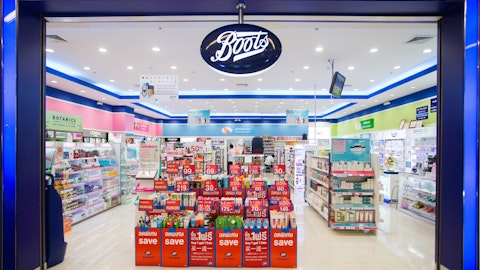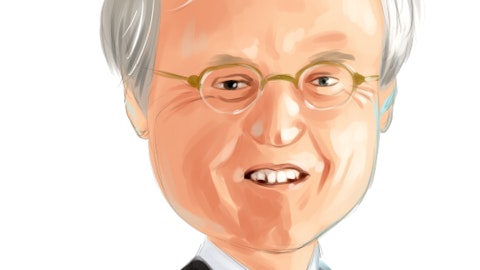Healthcare stocks, along with food and drink-related securities, are usually recommended as defensive holdings for recessions and bear markets, as individuals have to eat, drink and take medicine even amid economic hardship. Even so, the U.S. healthcare sector has turned out to be much more than a simple defensive investment strategy.
For instance, the Health Care Select Sector SPDR Fund (XLV), the largest exchange-traded fund in the health care sector, has returned nearly 101% over the past five years, versus the 56% return of the S&P 500 Index over the same time span. Meanwhile, the health care sector is anticipated to report the second-highest revenue growth of all ten sectors within the S&P 500 gauge for the second quarter, with the top line growth expected to reach 7.7%. Having this in mind, let’s have a look at the performance of five healthcare stock favored by the hedge fund industry tracked by Insider Monkey, as well as discuss the most important events that affected the performance of each of the five companies to date.
At Insider Monkey, we track around 730 hedge funds and institutional investors. Through extensive backtests, we have determined that imitating some of the stocks that these investors are collectively bullish on can help retail investors generate double digits of alpha per year. The key is to focus on the small-cap picks of these funds, which are usually less followed by the broader market and allow for larger price inefficiencies (see more details).

Nataliia K/Shutterstock.com
#5. Walgreens Boots Alliance Inc. (NASDAQ:WBA)
– Investors with long positions as of March 31: 72
– Aggregate value of investors’ holdings as of March 31: $5.29 Billion
– Q2 Return: -0.7%
There were 72 hedge fund vehicles followed by Insider Monkey with long positions in Walgreens Boots Alliance Inc. (NASDAQ:WBA) at the end of the March quarter, as compared to 78 registered at the end of the previous quarter. The money managers invested in WBA hoarded up almost 6% of the company’s total number of outstanding shares. WBA shares were down a little less than 1% in the second quarter of 2016, partially owing to the United Kingdom’s decision to leave the European Union earlier this month. The global pharmacy-led health and wellbeing enterprise has significant exposure to the U.K. after Walgreens acquired Boots Alliance, the biggest drugstore chain on the island, several years ago. In late October 2015, WBA inked a deal to acquire the third-largest drugstore in the United States, Rite Aid Corporation (NYSE:RAD). The acquisition of the drugstore chain with 4,560 stores across 31 states and the District of Columbia is anticipated to close in the second half of this year. Barry Rosenstein’s JANA Partners owned 10.58 million shares of Walgreens Boots Alliance Inc. (NASDAQ:WBA) at the end of March.
Follow Walgreens Boots Alliance Inc. (NASDAQ:WBA)
Follow Walgreens Boots Alliance Inc. (NASDAQ:WBA)
Receive real-time insider trading and news alerts
#4. Johnson & Johnson (NYSE:JNJ)
– Investors with long positions as of March 31: 77
– Aggregate value of investors’ holdings as of March 31: $5.25 Billion
– Q2 Return: 12.9%
Johnson & Johnson (NYSE:JNJ) received some love from the asset managers tracked by our team during the first three months of 2016, as the number of managers with stakes in the company spiked to 77 from 72 quarter-over-quarter. Our smaller-sized hedge fund industry appears to have made the right bet given that Johnson & Johnson’s shares gained nearly 13% during the June quarter. The health care and medical devices company has seen its market value jump by 18% thus far in 2016, primarily owing to two main reasons. The first reason involves the company’s recession-proof business model, as its healthcare products represent basic-need goods consumers buy regardless of economic conditions. Meanwhile, the second reason behind Johnson & Johnson’s strong performance relates to the strong growth of its high-margin pharmaceutical segment. The company’s pharmaceutical segment sales in the first quarter of fiscal 2016 that ended April 3 were $8.2 billion, an increase of 5.9% year-over-year. Ken Fisher’s Fisher Asset Management had 10.85 million shares of Johnson & Johnson (NYSE:JNJ) among its holdings at the end of the first quarter.
Follow Johnson & Johnson (NYSE:JNJ)
Follow Johnson & Johnson (NYSE:JNJ)
Receive real-time insider trading and news alerts
#3. Gilead Sciences Inc. (NASDAQ:GILD)
– Investors with long positions as of March 31: 93
– Aggregate value of investors’ holdings as of March 31: $4.01 Billion
– Q2 Return: -8.7%
The number of asset managers from our system with stakes in Gilead Sciences Inc. (NASDAQ:GILD) rose to 93 from 89 during the January-to-March quarter, whereas the overall value of those stakes fell by 11% quarter-over-quarter to $4.01 billion. The decrease was partially driven by an 8.8% drop in the value of Gilead shares, but the stock did not perform better in the second quarter of 2016 either. Gilead shares were down 8.7% for the quarter. The stock performance of the California-based drug marker has been weighted by increased pressure on the company to lower prices for its Hepatitis-C treatments. Gilead Sciences continues to hold a dominant 90% of the U.S. market share in Hepatitis-C with its Sovaldi and Harvoni drugs, but fast-toughening competition from industry peers AbbVie Inc. (NYSE:ABBV) and Merck & Co. Inc. (NYSE:MRK) led to increased pricing pressure. For instance, Gilead’s U.S. net product sales of Harvoni in the first quarter of 2016 were $1.4 billion, down from a much higher figure of $3.0 billion reported a year ago. John Armitage’s Egerton Capital Limited reported owning 4.52 million shares of Gilead Sciences Inc. (NASDAQ:GILD) in its 13F for the March quarter.
Follow Gilead Sciences Inc. (NASDAQ:GILD)
Follow Gilead Sciences Inc. (NASDAQ:GILD)
Receive real-time insider trading and news alerts
#2. Pfizer Inc. (NYSE:PFE)
– Investors with long positions as of March 31: 119
– Aggregate value of investors’ holdings as of March 31: $8.37 Billion
– Q2 Return: 19.8%
The elite corner of the hedge fund industry tracked by Insider Monkey increased its exposure to Pfizer Inc. (NYSE:PFE) during the first three months of 2016, as the number of funds with long positions in the company jumped to 119 from 109 quarter-on-quarter. Those 119 funds accumulated 5% of the company’s total number of outstanding shares. The shares U.S. pharma company gained 19.8% during the April-to-June period, reflecting investor confidence in the future prospects of the company despite the collapse of the planned $160 billion tie-up between Pfizer and Allergan plc (NYSE:AGN) in early April. The multi-billion-dollar inversion deal was pulled after the U.S. Treasury presented new rules to curb companies from moving their headquarters overseas to benefit from lower taxes. In late June, Pfizer completed the $5.2 billion-acquisition of Anacor Pharmaceuticals Inc., a deal announced shortly after the failed Pfizer-Allergan merger. Anacor’s flagship asset, crisaborole, is under review by the U.S. FDA for the treatment of eczema. Keith Meister’s Corvex Capital was the owner of 17.54 million shares of Pfizer Inc. (NYSE:PFE) on March 31.
Follow Pfizer Inc (NYSE:PFE)
Follow Pfizer Inc (NYSE:PFE)
Receive real-time insider trading and news alerts
#1. Allergan plc (NYSE:AGN)
– Investors with long positions as of March 31: 170
– Aggregate value of investors’ holdings as of March 31: $20.11 Billion
– Q2 Return: -13.8%
Allergan plc (NYSE:AGN) was the most popular stock among the hedge funds followed by Insider Monkey at the end of the March quarter. The number of asset managers invested in the Botox maker increased to 170 from 159 during the first three months of 2016. Those managers hoarded up 19% of the company’s outstanding shares at the end of March. Allergan has lost one-fourth of its market value since the beginning of 2016, mainly owning to the failed mega-merger with Pfizer. The stock lost almost 14% during the second quarter. Meanwhile, the Dublin-domiciled company is close to complete the $40 billion-sale of its generic-drug business to Israel-based Teva Pharmaceutical Industries Ltd (ADR) (NYSE:TEVA). At closing, Allergan will receive $33.75 billion in cash and 100.3 million Teva ordinary shares. The maker of cosmetic Botox plans to engage in smaller M&A deals to boost growth in the foreseeable future. John Paulson’s Paulson & Co. owns 5.42 million shares of Allergan plc (NYSE:AGN) as of March 31.
Follow Allergan Plc (NYSE:AGN)
Follow Allergan Plc (NYSE:AGN)
Receive real-time insider trading and news alerts
Disclosure: None





